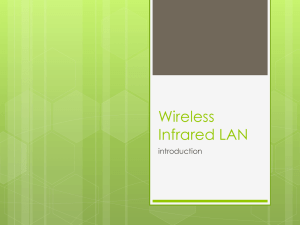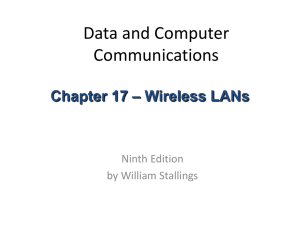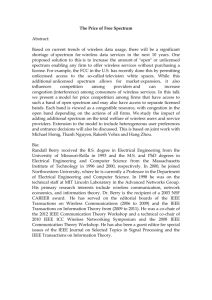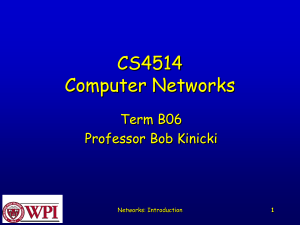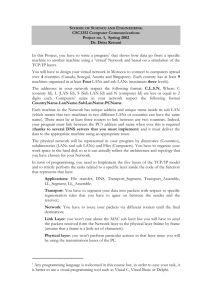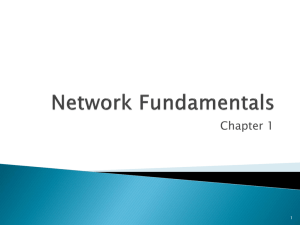Ppt
advertisement
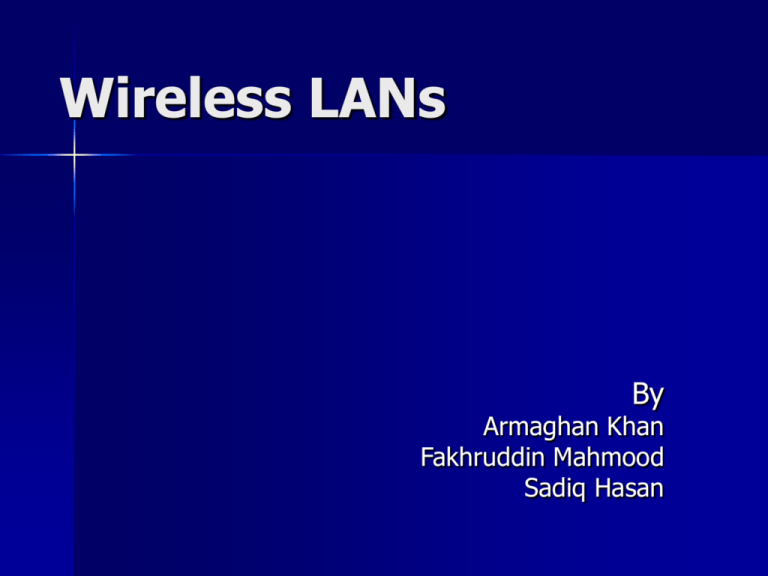
Wireless LANs By Armaghan Khan Fakhruddin Mahmood Sadiq Hasan Agenda 1. 2. 3. 4. 5. 6. Introduction How Wireless LANs Work? Technologies Involved Standards Advantages/Disadvantages Summary How WLANs Work WLANs Consist of 3 Components: 1) Wired Network 2) Access Point translates between wired LAN and wireless LAN 3) Wireless-LAN Adapters like PC cards Used by end users to access the WLAN How WLANs Work (Cont) How WLANs Work (Cont) Different Access Points Wireless LANs Technology There are 3 different types of wireless technologies Infrared Wireless LANs Spread Spectrum LANs Narrowband Microwave LANs Infrared LANs There are 3 types of Infrared transmission techniques 1. 2. 3. Directed Beam Infrared Omnidirectional Diffused Infrared LANs Directed Beam 1. 2. 3. Directed IR beams are used to create point to point links. A focussed IR beam can have a range of several kilometers. Can be used for cross building interconnection or for indoor interconnection of LANs Infrared LANs Omnidirectional A single base station which is within the line of sight of all wireless stations on the LAN. Mounted on the ceiling It acts as a multiple repeater and broadcasts a omnidirectional beam. The wireless stations transmit a directional beam aimed at the ceiling base unit Infrared LANs Diffused All the IR transmitters are focussed at a point on the reflecting ceiling. IR radiations striking the ceiling is reradaited omnidirectionally and picked up by all the receivers in the area. Infrared LANs Advantages 1. 2. 3. 4. 5. 6. Virtually unlimited bandwidth. Unregulated Spectrum. IR light is diffusely reflected by light-colored objects. Can use this property to provide coverage in presence of obstacles. Does not penetrate walls or other opaque objects. Easy to secure Separate networks can operate without interference Infrared LANs Disadvantages 1. 2. 3. 4. Interference from background radiation from sunlight. Power restrictions due to eye safety. Ambient radiation appears as noise in an infrared receiver. Transmitters of higher power required. Spread Spectrum LANs 1. 2. 3. Spread data transmission across the available frequency band in excess of minimum bandwidth required to send information. Makes it resistant to noise, interference, eavesdropping. Used with wireless LANs and other personal digital communication devices such as digital cellular phones. Spread Spectrum LANs Two of the most popular types of transmission using Spread Spectrum Analysis are: 1. Direct Sequence Spread Spectrum (DSSS) 2. Frequency Hopping Spread Spectrum (FSSS) Spread Spectrum LANs Direct Sequence Spread Spectrum(DSSS): 1. 2. 3. 4. 5. Most widely recognized form of Spread Spectrum. Converts an incoming data bit stream into a symbol stream. Each symbol represents a group of one or more bits. Using QPKS techniques it multiplies each symbol with a noise like code called pseudorandom noise sequence. Multiplication artificially increases used bandwidth based on the length of the chip sequence. Spread Spectrum LANs Frequency Hopping Spread Spectrum(FHSS) 1. 2. 3. Hops from narrow band to narrow band within a wide band. The hopping pattern or sequence appears random but is actually a periodic sequence tracked by sender and receiver. Can be susceptible to noise during any one hop but can achieve transmissions during other hops within the wideband. Spread Spectrum LANs Advantages 1. 2. 3. 4. Has the ability to eliminate or alleviate the effect of multipath interference. Can share the same frequency band (overlay) with other users. Provides privacy due to unknown random codes. Involves low power spectral density since signal is spread over a large frequency band. Spread Spectrum LANs Disadvantages 1. The bandwidth is inefficient 2. The implementation of the Spread Spectrum LANs is somewhat complex. Narrowband Microwave LANs There are basically two types of Narrowband Microwave LANs Licensed Narrowband RF Unlicensed Narrowband RF Narrowband Microwave LANs Licensed Narrowband RF 1. 2. Licensed within specific geographic areas to avoid potential interference. Motorola - 600 licenses in 18-GHz range Covers all metropolitan areas Due to licensing, independent LANs in nearby locations don’t interfere Encrypted transmissions prevent eavesdropping Guarantees interference free communication Narrowband Microwave LANs Unlicensed Narrowband RF 1. RadioLAN introduced narrowband wireless LAN in 1995. 2. Uses unlicensed ISM spectrum 3. Operates at 10 Mbps in the 5.8-GHz band 4. Range = 50 m to 100 m WLAN Standards: The IEEE 802.11 Original IEEE 802.11 Ammendments – 802.11a – 802.11b – 802.11g – 802.11n 802.11 Architecture Original IEEE 802.11 (WiFi) Formed in 1990 Operates in 2.4 GHz band Data rates of 1 & 2 Mbps 3 different technologies – Frequency Hopping Spread Spectrum (FHSS) – Direct Sequence Spread Spectrum (DSSS) – Infrared IEEE 802.11 Ammendments: 802.11a Ratified in 1999 uses Orthogonal Frequency Division Multiplexing (OFDM) Data rates of up to 54 Mbps Operates in 5 GHz band [free of interference] Reduced indoor range from 50 to 30m IEEE 802.11 Ammendments: 802.11b Ratified in 1999 Extension of original 802.11 uses a technique called Complementary Code Keying (CCK) Improved data rate of 11 Mbps IEEE 802.11 Ammendments: 802.11g Ratified in 2003 Operates in 2.4 GHz band Uses Orthogonal Frequency Division Multiplexing (OFDM) like 802.11a Data rates of up to 54 Mbps IEEE 802.11 Ammendments: 802.11n Announced in 2004 Expected in 2007 Will use Multiple-Input Multiple-Output (MIMO) technology Proposed data rate of 540 Mbps!!! IEEE 802.11 Architecture Components – Basic Service Set (BSS) – Access Point (AP) – Distribution System (DS) – Extended Service Set (ESS) – Portal IEEE 802.11 Architecture PORTAL LAN Other standards HiperLAN developed by European Telecommunications Standards Institute (ETSI) Also HiperLAN II OpenAir Developed by HomeRF private corporations SWAP Advantages of WLANs 1) Long-Term Cost Savings a) Eliminating the direct costs of cabling b) Effects of reorganization 2) Reduced Installation Time a) Eliminating the time needed for cabling b) reach places that cannot be reached by wires Advantages of WLANs (Cont) 3) Mobility - users can physically move while using the LAN - Examples: healthcare workers, policemen 4) Scalability a) Designed at any size, then can be expanded b) connect several buildings Advantages of WLANs (Cont) 5) Easy access to the Internet in public places -Examples: conference rooms ,hotels. Disadvantages of WLANs 1)Interference Same bandwidth like mobiles & microwave ovens. 2) Speed much less speed than that offered with wired LAN 3) Health Same health concerns as cell phones 4) Security any neighbor may be able to access to internal resources network
